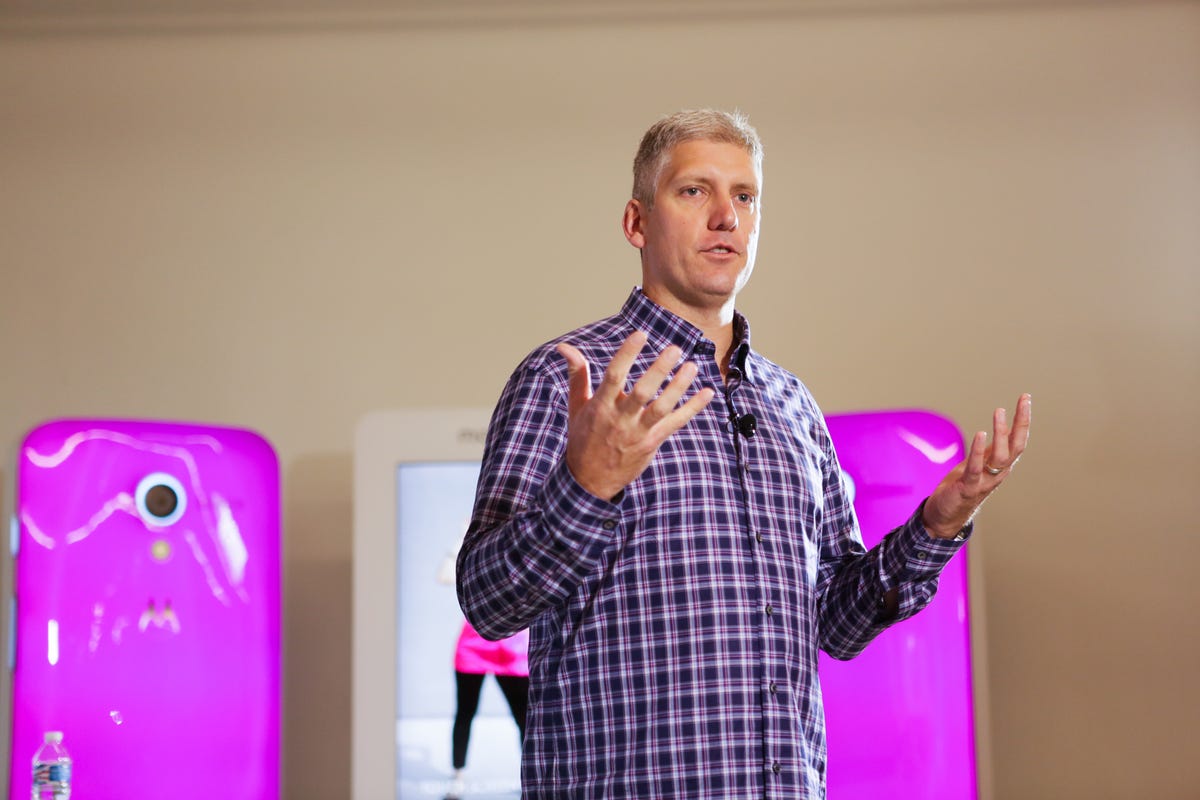
Sarah Tew/CNET
Motorola Mobility President and Chief Operating Officer Rick Osterloh is confident that the Moto X smartphone will be a top player in the market — even if it takes 10 years.
“We’re going to keep doing this until everyone knows about it,” Osterloh said in an interview on Thursday. “It might take 10 years, it might take two; it doesn’t matter to us.”
Motorola gets another shot with the latest version of the Moto X, which it unveiled Thursday alongside a new low-cost Moto G smartphone. The new version, which retains the same name, gets several improvements in its components, size, and material quality, with a price tag that’s lower than the original. It hits stores later this month.
Osterloh’s willingness to take a slow-and-steady approach with the Moto X brings certainty to what happens once Chinese electronics manufacturer Lenovo takes control of the business from Google in a deal scheduled to close by the end of the year. Skeptics question whether Motorola’s tactic of selling smartphones that undercut their closest competitors will remain once it becomes a Lenovo unit. Osterloh said Lenovo is fully behind Motorola.


Sarah Tew/CNET
“Lenovo knows all the details of what we’re working on and knows our strategy very well,” he said. “I’m very confident that what you see now will be our strategy in the long term.”
Lenovo declined to comment since the deal hasn’t closed.
Motorola and future parent Lenovo will need to exercise patience when it comes to the high-end smartphone market, particularly in developed countries such as the US. In these markets, Apple and Samsung Electronics rule, with the iPhone and Galaxy S flagship smartphone franchises dominating sales.
Motorola held 2.8 percent of the global market, up from 1 percent a year ago, according to IDC. Apple and Samsung combined for more than 37 percent of the market.
Osterloh conceded Motorola had a problem when it came to the awareness of its products. The original Moto X won critical praise for its use of hands-free controls and customizable look, but it barely made a dent in the market last year. That doesn’t faze Osterloh, who said he was focusing on making the experience positive for the consumers who do end up trying his products.
Take 2: Check out the new Moto X (pictures)






+9 more
“We’re very realistic about how hard it is to compete in developed markets that aren’t growing as fast at the high end of the market, but we’ll be around,” Osterloh said.
The reason for his optimism: Early success in critical growing markets such as India, where Moto X was briefly a top-three premium smartphone, and Brazil, where it was also highly ranked.
“If we keep doing this year after year, we’re confident we’ll be one of the top, if not the top smartphone all over the place in the high end and low end,” he said.
The availability of the Moto X just expanded into Mexico and Germany, and the company will shortly be in the UK and elsewhere in Europe. The Moto X will get broad carrier support, with sales staff trained on educating consumers on the benefits of its Moto Maker program, which allows people to tweak the colors and materials of the smartphone.
Last year, Motorola gave carriers black and white models of the Moto X, but this year it offered up different options to its partners. As a result, customers will be able to purchase a Moto X with a leather or wood backing directly from the store, emphasizing its unique look.


Sarah Tew/CNET
Potentially helping Motorola with its brand recognition is the introduction of the Moto 360 smartwatch, which is available today for $250. Motorola teased the Moto 360 in March when Google announced its operating system for wearables, Android Wear, and the circular design immediately garnered buzz over the other Android Wear devices, including LG’s G Watch.
While companies have been eager to bring out smartwatches — Samsung has released six different models over the past year — consumer enthusiasm has been muted. There still isn’t evidence that people are clamoring for these devices.
Motorola believes it can appeal to a broader audience because the Moto 360 is an aesthetically pleasing device.
“The offerings to date have appealed to people interested in tech,” Osterloh said. “They’re not bringing back the 70 percent of people who stopped wearing their watch because they get their time from their phone.”
The added benefits of a heart rate monitor, fitness tracking capabilities, and alerts from the smartphone may draw in consumers who have previously abandoned their watches, he said.
Motorola isn’t the only one bringing out a circular watch. LG recently showed off the G Watch R, an Android Wear-powered smartwatch with its own circular face. Osterloh was quick to point out that the G Watch R hasn’t shipped yet and said he wasn’t surprised that others would attempt a circular watch.
Osterloh said he had no expectations for how the watch would do since it was such early days for the market.
“Our philosophy in general is if we build products that people like, then eventually the business will take care of itself,” he said.



